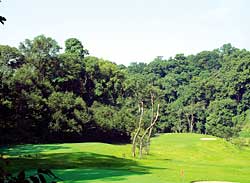 Amongst the top attractions of playing golf is the environment a golf course provides.
Amongst the top attractions of playing golf is the environment a golf course provides. One could safely say that a majority of golfers live in cities, and that getting away to large, beautifully landscaped havens of trees and grassy expanses provides a respite from the daily barrage of pollution, noise and unnatural visual stimuli of a city's concrete jungle. Those who do not partake in this sport would find similar solace in public or protected natural parks, or areas less touched by the urban sprawl.
In Nepal, protecting forests and natural areas is a hard battle. There is indiscriminate cutting of trees, both in and out of our cities, and the upkeep of public parks proves difficult due to limited interest or budgets.
An average 18-hole golf course occupies between 100 to 140 acres of land (800-1,100 ropanis). Within or near cities, this is a significant area: this land could have been used for housing, industry, buildings, parks and farming. So what is the trade off to the ecology of the environment and the use of land in creating a golf course?
Even though I am not an environmentalist, I thought it would be interesting to lay down some thoughts. Golf courses built recently are usually constructed on farm, waste or zoned land that requires green-belt areas, and less often on uninhabited land or within preserved areas that require ecological care through consideration of environmentally sensitive parts.
With any development of land, or land use, there is a change from what used to be to what will be. Much of the farmland in Nepal used to be forest. In fact most of Kathmandu Valley outside the centers of the three main cities used to be forested till not so long ago.
Today, if one were to build a new golf course in the Valley within easy reach, it would almost necessarily have to be on farmland. What changes would occur should this happen? A handful of farmers would sell their property, and either use that money to move elsewhere outside the Valley, or perhaps invest it in some other property and trade. The land would then be developed into a green area for sports recreation use and as a tourist attraction.
If any trees on the land being developed were cut down, these would, or should be replaced by planting many more new ones elsewhere within the area. Forested high-lying areas if any, are usually where wildlife would reside, and should be handled with care. If more trees are planted than were there before, this would enhance the environment and provide a sanctuary to wildlife and some of Nepal's many birds.
Water would be needed to maintain the grass, and this would be tapped in ways similar to what farmers use now, perhaps drawing on bore wells during the drier seasons. Having a lot of porous surface, unlike built up areas, roads and paths, the water used would get a chance to replenish the ground water table. Additionally, areas where erosion of soil could take place due to earth movement during landscaping would have to be taken into account.
The top qualities of grass needed would entail application of fertiliser, pesticide, and fungicides. As with all applications of chemicals, including those used for farming, if used carefully and in moderation, the effect on the environment would be a lot less adverse than say textile dying units pumping untreated chemical waste into our rivers or toxic emissions from our adulterated-petrol consuming vehicles and brick kilns. Speaking of which, have you wondered which is a better use of land close to populated areas-a lush green self-sustaining golf course with trees and grass or a brick factory?
There are pros and cons everything. All of us in the world today live at the cost of nature, and knowingly or unknowingly affect the environment and the ecology everyday in almost everything we do, from farming to consuming water, driving our vehicles to using anything dependent on electricity, whether it is produced through burning fossil fuel or through dams constructed to produce hydroelectric power.
Time to lay these thoughts aside and enjoy the lush green fairways, beautiful surroundings and an enjoyable round of golf.
Deepak Acharya is a golf instructor and Head Golf Professional at Gokarna Forest Golf Resort & Spa, Kathmandu. [email protected]



